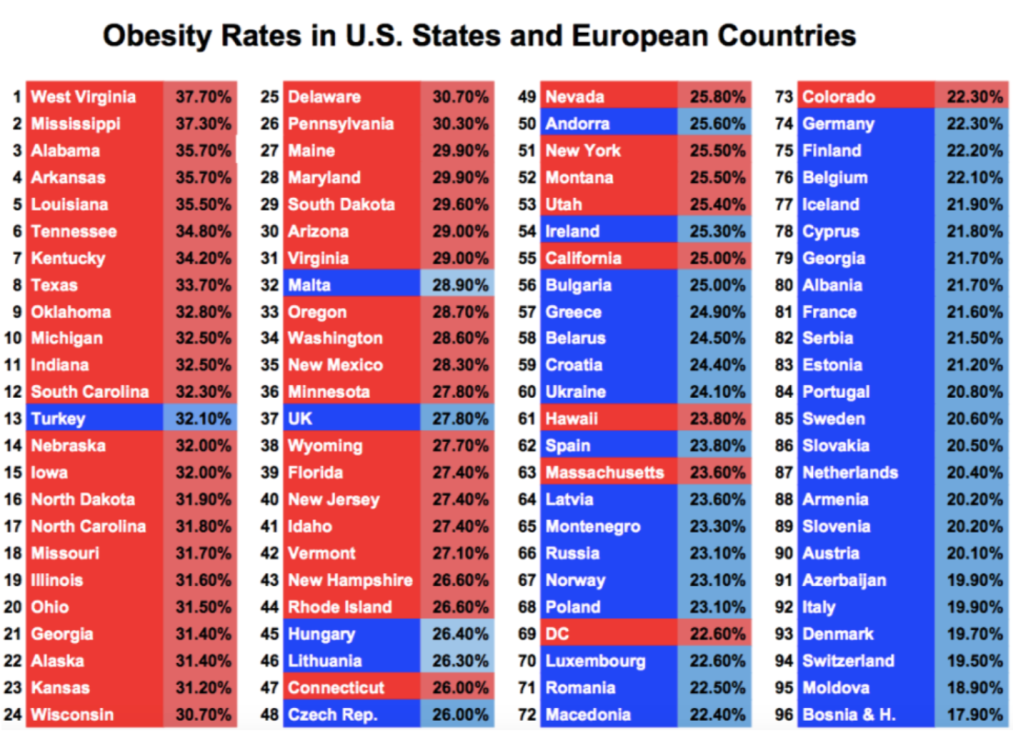Fair warning, this post might be a little bit rant-y but just the beginning of it. Scroll down for some cold hard statistics.
Honest question: Is there any non-pretentious way to start a blog post with: “So I just got back from Europe?” I’m asking for a friend. 😉
The Rant
So… I just got back from Europe. When I travel, sometimes my digestion system has a bit of a slow and uncomfortable adjustment to the new / different food, the usually lesser amount of water than I usually drink at home, and higher amounts of wine, and potentially a time change, a bit of tourist anxiety, ya know… the usual travel drama.
I just spent two weeks in Madrid eating jamon/ham, bread, vermouth, tomatoes, and various other types of tapas, and a bit over a week in France eating all sorts of unpasteurized cheeses, at least one, if not more (I maxed out at 3 one day) croissants per day, LOTS of wine, French sausages, pastries, crepes, etc, etc. Then I came back to the USA.





One thing I realized halfway through my trip is that I hadn’t been having any digestion disruptions or disturbances. I wasn’t bloated (although I was walking a decent amount each day, but I exercise at home most days too); I didn’t feel like I was having any issues with the food. I was confused. I thought for sure that my body would have reacted to the change in diet and given me hell for it. So on the flight home I was feeling sort of smug… like I just spent three weeks abroad, and my bathroom visits were excellent (this is a blog post about digestion… okay…. everyone poops, sorry for saying the word). Well…. 3 days after arriving home and going back to my normal routine… WAR. I’m not sure if I had too many tacos, or too little wine (is that a thing?), or what happened. But it got me thinking: What the heck are we eating in the USA? And I’m not talking about fresh food vs. frozen meals, and things like that… I’m talking about what’s in the food that we have no control over. Things like pasteurized dairy that leaves out some of the important bacteria you need to digest the food properly. What is in our meat that we don’t know about? Do we have any choice in that REALLY without going bankrupt from trying to eat farm fresh 24/7?
So that’s the rant. I don’t have the answer. I do believe part of it is the lifestyle that most Americans have where we sit at a desk, lay around at home, spend all evening watching TV, etc, etc. One thing you notice in Europe is that there are FAR less people who are overweight… why is that? This lead to some hard core research, and I love stats and facts.
72 percent [of Americans surveyed] said they have experienced at least one gastrointestinal (GI) symptom a few times a month or more. Surprisingly, a majority of surveyed participants (74 percent) have lived with their GI symptoms for more than six months.
–Abbvie
Before I dive into some more interesting statistics I found, I can’t help but share a few more photos of my eating adventures in Europe.



If anyone needs tips on where to taste some incredible wine in Bordeaux (you don’t have to visit hundreds of Chateaux to taste hundreds of wines!), let me know and I’d be happy to share all of my research!

The Data
Here are some interesting stats about health in the USA and health in Europe that I thought were interesting while plunging down the internet rabbit hole, trying to find answers to my questions.
This study found that nearly 40% of Europeans suffer from some kind of gastrointestinal disorder.
According to CBS News, 15% of Europeans are considered obese, while 37% of Americans are considered obese.
“Overweight” is considered between 25-29.0 BMI while “obese” is a BMI of 30 or more.
Check out this article for some really interesting information comparing the United States with the European countries in levels of obesity. This graphic is what I found the most interesting (graphic credit: BigThink.com).

France is one of the “healthiest” countries according to this New York Post article. Even though the French diet is filled with buttery croissants, and high fat cheeses, one of the biggest differences is not only WHAT the French eat, but HOW they eat it. The French consider mealtime a social event, compared to a large number of people in the US that eat in front of their TV, or eat as quickly as possible to get to the next event in the schedule. If you’re eating in front of your TV, you can easily loose track of how much you’ve eaten, and overeat.
This study (from StudyFinds.org) found that 88% of American adults are “zombie eaters” and are watching some kind of screen while eating meals. Why not try being more mindful while eating?
According to this article from The Guardian, the French spend two hours, 22 minutes a day, eating meals.
This is a really interesting article from Statista that shows the average time spent eating for 15 surveyed countries around the world. The USA ranks last with 1 hour and 2 minutes of time spent eating per day. That’s about 20.7 minutes per meal if you eat three meals.

So I know that the amount of time we spend eating can’t be the only thing affecting us. What about physical movement? Europeans seem to be out on the street a lot more than Americans, and a lot more of them use public transportation (and their own two feet) to get more places while we tend to hop in the car to get where we need to be.
According to this USC-led study on inactivity, Americans are much more inactive than Europeans, and Americans THINK they are a lot more active than they actually are.
Here are three quick stats that could be related (and they are at least interesting). The USA is ranked 50th in average life expectancy, behind most European countries (actually behind countries from all over the globe). The USA ranks 20th in “highest quality of life” (behind France, Spain, Italy, and other European countries). One thing though is that the USA ranks 6th in “Best Country Overall”, check out the top 5 here.
Maybe the point I’m trying to make to myself is: we need to be more mindful when we eat, and stay active. Simple, right? *the audience erupts with laughter.* Well, we’re all on our own journey of trying to live our best lives (which includes being physically able to do what we want to do, and eat what we want to eat). I hope some of this information was interesting, and maybe some of it was educational. Don’t you worry my friends, I still like to eat ;). I don’t think anyone was worried, but I thought I would clarify, just in case.
For now, I will leave you with this: A reminder to get out there and move a little bit. The CDC says on their website that “inactivity contributes to 1 in 10 premature deaths.”
Cheers,
Dan

Hi Dan, I encountered your Blog with the description of the Iw&fs dinner at June. I was very impressed. I am also so very excited about your intense energy and interest in the Philadelphia branch. Let’s be sure to talk at the picnic on the 19th of September. Best regards, Hal
LikeLiked by 1 person
Hi Hal! Thanks for stopping by my website. I’m very much looking forward to the picnic and chatting. See you soon.
Best,
Dan
LikeLike
Hi Dan! This was so validating to read. I have the same exact experience. I eat whatever I want in Europe and have minimum tummy issues. Then I come home to America, eating *better* and I have awful tummy issues. WTF?! I’ve been going to a gastrologist for over a year without any answers and now I’m going to make sure they take this more seriously!! There has to be something that America does or doesn’t put in their food that hurts me, compared to Europe. Have you ever found more on the topic?
LikeLike